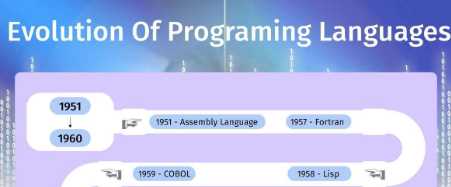In the ever-evolving world of software development, programming languages and frameworks play a vital role in shaping the way we create, build, and innovate. From the early days of programming to the present, this blog takes you on a journey through the fascinating evolution of software development languages and frameworks.
The Birth of Programming Languages
The concept of programming languages emerged in the mid-20th century, as early pioneers sought ways to communicate with computers more effectively. Fortran, developed by IBM in the 1950s, became the first high-level programming language. Its introduction marked a significant shift from machine language and assembly language, making programming more accessible and efficient.
The Rise of General-Purpose Languages
As the demand for software increased, programming languages such as COBOL, ALGOL, and BASIC were developed to cater to various application domains. These general-purpose languages provided a more intuitive and human-readable syntax, allowing programmers to focus on problem-solving rather than low-level machine instructions.
Object-Oriented Paradigm and C++
The introduction of object-oriented programming (OOP) in the 1970s brought a new level of abstraction and modularity to software development. Simula, one of the first programming languages to support OOP concepts, laid the groundwork for future advancements. In the 1980s, C++ was developed as an extension of the C programming language, introducing features like classes, inheritance, and polymorphism. C++ became immensely popular and remains a widely used language today.
The Web Revolution and JavaScript
The birth of the World Wide Web in the 1990s sparked a revolution in software development. With the need to create dynamic and interactive web pages, JavaScript emerged as the language of choice. Initially limited to front-end development, JavaScript soon found its way into server-side development with Node.js, allowing full-stack JavaScript development.
The Era of Frameworks
Frameworks played a crucial role in simplifying and speeding up software development. The late 1990s saw the rise of PHP, which became a dominant language for web development, especially in conjunction with popular frameworks like Laravel and Symfony. Around the same time, Python gained popularity due to its simplicity and versatility, coupled with frameworks like Django and Flask.
The Rise of Java and Enterprise Development
Java, released in the mid-1990s, revolutionized enterprise software development. It brought platform independence, robustness, and a vast ecosystem of libraries and frameworks. Java Enterprise Edition (Java EE) enabled developers to build scalable, distributed applications for businesses. Frameworks like Spring and Hibernate further simplified Java development, fostering productivity and maintainability.
Modern Web Development and JavaScript Frameworks
As web applications became more complex, JavaScript frameworks such as Angular, React, and Vue.js emerged, enabling developers to build rich and interactive user interfaces. These frameworks facilitated the development of single-page applications and brought about the concept of component-based architecture.
The Emergence of Dynamic Languages
Dynamic languages like Ruby and Python gained prominence for their simplicity, readability, and productivity. Ruby on Rails, a web development framework, and Django, a Python web framework, accelerated the development of web applications by embracing convention over configuration principles.
The Advent of Functional Programming
Functional programming languages like Haskell, Erlang, and Clojure started gaining attention due to their focus on immutability and declarative programming paradigms. These languages offered solutions to complex problems, particularly in areas such as concurrent and distributed systems.




Leave Comment